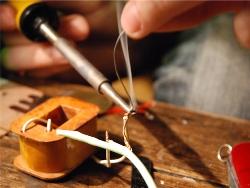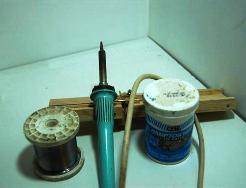Categories: Novice electricians, Safety precautions
Number of views: 46434
Comments on the article: 1
What is soldering? Soldering Safety
 One of the most useful skills of any person professionally associated with the maintenance and repair of various electrical and electronic devices and devices is ability to solder. In this article, we will consider basic concepts and rules that you must know before proceeding with the soldering process. The main emphasis in the article is made on the consideration of safety rules when soldering.
One of the most useful skills of any person professionally associated with the maintenance and repair of various electrical and electronic devices and devices is ability to solder. In this article, we will consider basic concepts and rules that you must know before proceeding with the soldering process. The main emphasis in the article is made on the consideration of safety rules when soldering.
For starters, a little theory of what soldering
Brazing is a method of joining metals using another, more fusible metal. The soldering process is the penetration of one substance (metal) into another at high temperature, which provides after hardening of the solder mechanical strength and high electrical conductivity of the connection. Soldering usually occurs at high temperatures of soldered surfaces and molten tin (from 180 to 250 ° C). In this process, one of the metals is the welded conductors, the second is solder.
So, soldering - the process used to obtain a permanent connection of metal parts from various materials by introducing between these parts a molten material (solder) having a lower melting point.
But what about welding is said in the encyclopedic dictionary: “This is a technological operation used to obtain an inseparable mechanical and electrical connection of parts from various materials. The soldered elements of the parts, as well as the solder and flux, are brought into contact and are heated with a temperature above the melting point of the solder, but lower than the melting temperature of the parts being joined. As a result, the solder goes into a liquid state and wets the surfaces of the parts. After this, the heating stops, and the solder goes into the solid phase, forming a compound. The parts and solder are heated with a special tool called a soldering iron. "
Different types of soldering irons and various types of solders and flux are used depending on the type of parts that undergo the joint, the required joint strength. How to choose the right soldering iron, solder and flux for different types of soldering will be described in the following articles about soldering.
It can be seen from the definition above that soldering is based on the phenomenon of diffusion, i.e., on the mutual penetration of the particles of molten solder and the base metal into each other. This penetration provides mechanical strength and high electrical conductivity of the joint after hardening of the solder.
It should be noted that the metal surface in air is usually covered with a layer of oxide, so it needs to be cleaned before soldering. But the cleaned surface can again quickly oxidize. To avoid this, chemical substances - fluxes are applied to the treated places. We will consider them in more detail below.
Fluxes increase the fluidity of molten solder. Thanks to this, the soldering is stronger. For radio installation work, acid-free fluxes, such as rosin, are usually used.
As a result of soldering, a mechanical and electrical contact is formed between the metal surfaces, capable of withstanding significant mechanical loads.
Some useful tips
For high-quality soldering, it is not enough to heat one surface with tin and lean against it another: an indispensable condition for the formation of reliable contact is equal temperatures of the soldered surfaces. Naturally, this can only be achieved with a correctly selected tool.
For the quality of soldering, the ratio of the temperature of the tip of the soldering iron and the melting temperature of the surf is very important:
- the low temperature of the soldering iron tip will soften the solder, but not its melting. The result is cold soldering (you can find out by the granular structure of the contact).
- high temperature of the soldering iron tip - excessive evaporation of solder. Both that and other defect leads to scattering and stratification of contact after some time of operation.
Electrical safety rules for soldering
Actually, with the rules of electrical safety, it would be worth starting this article. But better late than never. So, when soldering, be sure to observe the electrical safety rules! Remember that a soldering iron is a tool of increased danger, so you must handle it very carefully!
Doing work, do not talk and do not be distracted by extraneous matters!
Working with an electric soldering iron is not safe - you can get burned, as the copper rod and the soldering iron cover are heated to high temperature. Therefore, it is necessary to hold a heated soldering iron only by the handle and not touch its heated parts. In addition, it must be ensured that the heated parts of the soldering iron do not touch the insulation of the supply wire or cord, since a hot casing or rod can cause insulation failure, short circuit and fire.
When soldering electronic devices, the power wires must be disconnected from them, or the switch must be bipolar (disconnecting both wires). It is very dangerous to solder an electronic circuit that is turned off but connected to ground, while the insulation of the soldering iron is weak or the body of the soldering iron is not grounded! On the Internet, cases are described when someone forgot or ignored this rule, and when a soldering iron touched a circuit, a powerful arc of several kilowatts arose.
The same rule applies to information wires. Suppose you turned off the power or pulled out a 220 V cord, and the device is connected via an information cable to other devices that are energized or grounded. Even a small potential can ruin the electronic circuit when touched with a soldering iron. Therefore, it is necessary to equalize the potential by connecting the wire between the body of the soldering iron with the common bus of the device before soldering.
Is soldering harmful?
 Unsafe tin and lead vapors may be released during soldering. In no case should you bend over the place of soldering and breathe in fumes. In summer, try to solder near an open window; in winter, often ventilate the room during work. After soldering, be sure to wash your hands with warm water and soap.
Unsafe tin and lead vapors may be released during soldering. In no case should you bend over the place of soldering and breathe in fumes. In summer, try to solder near an open window; in winter, often ventilate the room during work. After soldering, be sure to wash your hands with warm water and soap.
Lead-free solder uses metals that are more toxic than lead. If the soldering iron is not overheated, and not a hundred-watt “for soldering buckets”, then everything will be fine.
Soldering at home can be subject to the following considerations:
- when soldering, do not forget to work in a well-ventilated area,
- if there is a fan, use,
- if there is a professional or home-made ventilation system - great,
- it is advisable not to breathe in rosin pairs,
- do not solder in the kitchen, because pairs of solder and rosin easily settle on cutlery and food,
- it is best to use a long-sleeved work dressing gown that we don’t forget to wash at least occasionally,
- after soldering, carefully wipe the table, etc., i.e. household items,
- after soldering, thoroughly (!) with soap (!) wash your hands and face!
Do not neglect the simplest safety rules for the sake of laziness! It will not decrease from you, but claims from relatives will decrease.
For those involved in soldering, in order to remove heavy metals from the body, you need to drink a glass of plum juice daily, and after about an hour a couple of glasses of fermented milk product, for example, kefir. Milk must be drunk by those associated with chemistry. These are safety regulations developed back in the USSR period.
Useful advice on how to protect yourself from splashes when soldering
Apply a minimum amount of flux. In excess - may splash when touched with a soldering iron. We take as much solder with a soldering iron as necessary for 1-2 soldering, the excess can drip and burn.
Splashing molten solder into the eye is not easy, but VERY SIMPLE. To do this, take the wiring in the hand or a part with thin springy terminals. We push the soldering iron away from the tip of the wire with a drop of solder, and suddenly ... Consistently excellent result - the solder flies right into the eye.
Therefore wear special glasses. By the way, the market very often sells a cheap fake for goggles. Outwardly, you can’t tell them apart !!! Only for the price. But they strongly press on the skin with a sharp edge, that is, the plastic there is a little tougher. In general, does not wrap around the skin. You can’t sit in such glasses for a long time, therefore, buy expensive glasses.
Continuation of the series of articles about soldering: How to choose a soldering iron and organize a soldering workstation
See also at bgv.electricianexp.com
:
